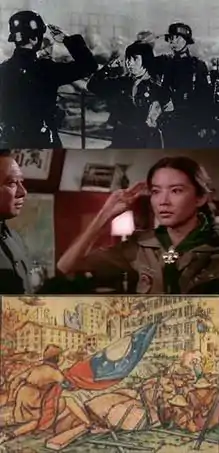Defense of Sihang Warehouse
The Battle of Sihang Warehouse (Chinese: 四行倉庫保衛戰) took place from October 26 to November 1, 1937, and marked the beginning of the end of the three-month Battle of Shanghai in the opening phase of the Second Sino-Japanese War. Defenders of the warehouse held out against numerous waves of Japanese forces and covered Chinese forces retreating west during the Battle of Shanghai.
| Battle of Sihang Warehouse | |||||||
|---|---|---|---|---|---|---|---|
| Part of the Battle of Shanghai in the Second Sino-Japanese War | |||||||
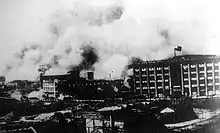 Sihang Warehouse during the battle | |||||||
| |||||||
| Belligerents | |||||||
|
|
| ||||||
| Commanders and leaders | |||||||
|
|
| ||||||
| Units involved | |||||||
|
| ||||||
| Strength | |||||||
| 410-420 soldiers[2] | ~1180 sailors[3][4] | ||||||
| Casualties and losses | |||||||
|
Xie's Claim:[5] 10 killed 37 wounded 2022 Western Estimate:[6] 33 killed and missing 37+ wounded Japanese Claim: ~80 killed[7] |
Japanese Claim: 1 killed, >40 wounded[8][9][7] Initial Chinese Claim: 100+ killed[10] Postwar Chinese Claim: 200+ killed[11][12] Hundreds wounded 4 tanks destroyed or damaged[5] Several armored cars destroyed or damaged | ||||||
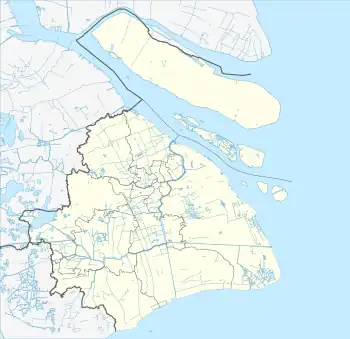 Location within Shanghai | |||||||
| Sihang Warehouse | |||||||
|---|---|---|---|---|---|---|---|
| Chinese name | |||||||
| Traditional Chinese | 四行倉庫 | ||||||
| Simplified Chinese | 四行仓库 | ||||||
| |||||||
| Eight Hundred Heroes | |||||||
| Traditional Chinese | 八百壯士 | ||||||
| Simplified Chinese | 八百壮士 | ||||||
| |||||||
| Japanese name | |||||||
| Kanji | 四行倉庫 | ||||||
| |||||||
Accounts from Chinese, Japanese, and Western sources on the Defense of Sihang Warehouse vary significantly in nature, with both Chinese and Western accounts remembering the conflict as an excellent defense against a vastly numerically superior enemy, while Japanese records point to the defense being a relatively unremarkable event within the entire Battle of Shanghai. As Chinese memoirs and Japanese combat reports for the event largely contradict each other, there remains debate over what truly occurred during the defense.
Regardless of the integrity of Chinese and Japanese claims, the defense of the warehouse and media reporting of the event provided a morale-lifting consolation to the Chinese army and people in the demoralizing aftermath of the Japanese invasion of China.[13] The warehouse's location just across the Suzhou Creek from the foreign concessions in Shanghai meant the battle took place in full view of the western powers.
Because of the warehouse's proximity to the foreign concessions in Shanghai, the Japanese did not use naval bombardment on the area, since a stray shot might land in the concessions and provoke an incident with the Europeans and Americans, whom the Japanese wanted to keep out of the war. Moreover, the Japanese dared not use mustard gas here as they did elsewhere in Shanghai, in full view of the foreign powers. This proximity drew the attention, if only briefly, of the international community to Chiang Kai-shek's bid for worldwide support against Japanese aggression.
In Chinese, the warehouse defenders are known as the Eight Hundred Heroes, because commander Xie Jinyuan, not wanting to reveal their true strength to the Japanese, provided an exaggerated number to Girl Guide Yang Huimin to announce to the public.
Background
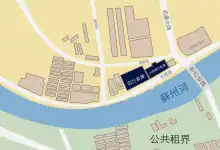
Using the Marco Polo Bridge Incident as a pretext, the Imperial Japanese Army launched an invasion of China on 7 July 1937. As the Imperial Japanese Army swept down from the north, fighting between Chinese and Japanese forces started in Shanghai on 13 August. Despite having logistical problems, inferior equipment and training, and a lack of air and heavy artillery support, the Chinese held on to Shanghai, much of it reduced to ruins in the three month battle.
However, the Japanese did not attack the foreign concessions in the city and remained on peaceable terms with the foreign powers, though tensions were high. They did not occupy the concessions until four years later, following Japan's decision to go to war against the Allies.
By 26 October 1937, Chinese resistance in the district of Zhabei was faltering. Generalissimo Chiang Kai-shek wanted to withdraw all forces in the area to defend the rural western regions of Shanghai, and ordered Gu Zhutong, acting commander of the 3rd Military Region, to leave the 88th Division behind to buy time and canvass international support by showing the other nations of the Nine Powers (which were to convene on 6 November) China's determination to resist the Japanese war of aggression.[14]
Gu was personally attached to the 88th and unwilling to leave the division behind, as he used to be the commanding officer of the 2nd Division, which became the 88th after reorganisation. He telegraphed the 88th's divisional commander Sun Yuanliang, who vehemently opposed this plan and sent his chief of staff Zhang Boting (張柏亭) to Gu's Headquarters, about 20 km from the frontlines, to argue against it.
Neither Gu, Sun nor Zhang were about to disobey Chiang's orders, but Sun (via Zhang) suggested to Gu that the number of troops left to cover the withdrawal would not matter for such a show of determination. In his words, "How many people we sacrifice would not make a difference; it would achieve the same purpose."[15] He proposed that a single regiment from the division be left behind to defend one or two fortified positions, and Gu approved this plan. Zhang returned to the 88th's divisional headquarters at Sihang Warehouse. There, Sun decided that even a regiment would be a terrible waste of lives and decided on a single over-strength battalion instead. Xie Jinyuan (謝晉元), a relatively new commander in the 88th Division, volunteered to lead the battalion.
At 10 p.m. on 26 October, the 524th Regiment, based at the Shanghai North Railway Station, received orders to withdraw to the divisional headquarters at Sihang Warehouse. 1st Battalion commander Yang Ruifu was distraught at having to abandon a position he had held for more than two months,[16] but agreed to do so after being shown Sun's orders for the 1st Battalion to defend Sihang Warehouse.
The warehouse, also known as the Chinese Mint Godown by those from the concessions, is a six-story concrete building situated in Zhabei District north of Suzhou Creek, at the north-western edge of New Lese Bridge (now North Tibet Road Bridge). Built jointly by four banks—hence the name Sihang (literally meaning, Four Banks)—in 1931, it sits on a 0.3-acre (1,200 m2) plot of land, with an area of 20,700 square metres (223,000 square feet), 64 metres (210 feet) wide by 54 metres (177 feet) long, and 25 metres (82 feet) high, making it one of the tallest buildings in the area. The warehouse, used as the divisional headquarters of the 88th Division prior to this battle, was stocked with food, first aid equipment, shells and ammunition.
Order of battle and equipment
National Revolutionary Army
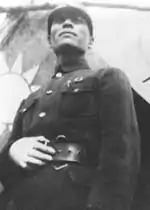
- 524th Regiment, 88th Division: Regimental commander (CO), Army Lieutenant Colonel Xie Jinyuan
Executive officer (XO), Army Major Shangguan Zhibiao (上官志標)- 1st Battalion, 524th Regiment: Battalion Commander, Army Major Yang Ruifu (楊瑞符)
- 1st Company, 1st Battalion: Company commander, Army Captain Tao Xingchun (陶杏春)
- 2nd Company, 1st Battalion: Company commander, Army Captain Deng Ying (鄧英)
- 3rd Company, 1st Battalion: Company commander, Army Captain Shi Meihao (石美豪, wounded), Army Captain Tang Di (唐棣)
- Machine Gun Company, 1st Battalion: Company commander, Army Captain Lei Xiong (雷雄)
- 1st Battalion, 524th Regiment: Battalion Commander, Army Major Yang Ruifu (楊瑞符)
Initially containing around 800 men, the 1st was technically an over-strength battalion, but casualties suffered over the course of the Battle of Shanghai reduced its actual strength just prior to the battle to 452 men (some sources give 423), including officers. Because of the confusion of the general retreat, some units may have failed to make it to the warehouse, which caused a further reduction in strength, down to only 414 men present at the beginning of the battle. Two months of intense fighting had also whittled down the original German-trained troops, and after five rounds of reinforcements, the majority of soldiers and officers in the battalion were garrison troops from the surrounding provinces.[17]
Most of the men were from the 1st Battalion, 5th Regiment of the Hubei Provincial Garrison. Hubei did not want to send its best troops to Shanghai, as these had trained over a decade to fight against the Chinese Communists. Thus, many of the soldiers sent as reinforcements to Shanghai were green recruits, with the latest batch recruited after the outbreak of war on 7 July.[15] Official communications referred to the defenders as the 524th Regiment to mislead the Japanese as to their actual strength, even though only the 1st Battalion took part in this battle, and other elements of the regiment continued to be active well into 1939. Eventually the 1st Battalion came to be equated with the 524th Regiment, even within official documents of the period.
The regiment was assigned used equipment from the front-line troops of the 88th, and was well equipped considering the poor equipment that most Chinese forces had. Photos and records show that soldiers were each issued a rifle, likely a Hanyang 88 or Chiang Kai-shek rifle, 300 rounds of 8 mm Mauser, two crates of grenades, a German-made M1935 helmet, a gas mask, and food pouch.[16] There was a total of 27 light machine guns, mostly Czech ZB vz.26, approximately one for each squad. The four water-cooled Type 24 Maxim guns were the only heavy weapons available to the battalion—a mortar platoon assigned to them was never mentioned by participants of the battle, and was therefore unlikely to have joined the battle.[15]
Imperial Japanese Navy
- Shanghai Special Naval Landing Force: Rear Admiral Okochi Denshichi
- Shanghai SNLF 10th Battalion: Lieutenant-Commander Haji Kitaro
- Shanghai SNLF 8th and 9th Companies
Since 1927, the Imperial Japanese Navy had stationed naval landing forces in Shanghai for the protection of Japanese expatriates and their interests in the city. On June 1, 1932, in the aftermath of the January 28th Incident, the naval landing forces in Shanghai were organized into a permanent force protection of the city known as the Shanghai Special Naval Landing Force (Shanghai SNLF).
Captain Okochi Denshichi had been assigned command of the Shanghai SNLF on November 16, 1936, and was promoted to Rear Admiral at the beginning of the following month. Prior to the Battle of Shanghai the Shanghai SNLF had a strength of just over 2300 men, but in response to the Oyama Incident on August 9, 1937, the force would be hastily reinforced with Special Naval Landing Forces and ship crews deployed on land. Reinforcements would continue to arrive throughout the course of the battle, eventually bringing the force to just over 10,000 men in strength by October 1937.[4]
On October 27, 1937, the Shanghai SNLF began their advance on Chapei, organizing their 2nd, 3rd, 6th, 10th, and 12th Battalions into the “Chapei Force” for the operation. The Shanghai SNLF 10th Battalion would be assigned to the Chapei Force’s Southern Section and serve as the main force opposing the defenders of Sihang Warehouse.[18]
The 10th Battalion had been raised in August 1937 from some 520 reservists at the Sasebo and Kure Naval Districts. Lieutenant Commander Haji Kitaro, an instructor at the Naval Gunnery School in Yokosuka was appointed as to the Shanghai SNLF to serve as the battalion's commander.[19] Since landing in Shanghai on August 19, the battalion had engaged in intense urban combat and suffered a number of casualties.
During the assault on Sihang Warehouse, the Shanghai SNLF 10th Battalion would be reinforced by roughly 260 sailors of the Yokosuka 2nd Independent SNLF Company and another 200 sailors from the Kure 1st SNLF 2nd Company. The Shanghai SNLF’s 8th and 9th Companies, originally attached to the 4th Battalion (Artillery Battalion), would also provide support with howitzers and mountain guns.[3][4][20]
Altogether about 980 infantrymen from the Shanghai SNLF’s reinforced 10th Battalion and another 200 artillerymen from the 8th and 9th Companies were involved in the Japanese assault on Sihang Warehouse.
Battle
October 27
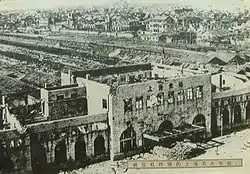
The various companies of the battalion were spread out across the front lines that night. Yang Ruifu sent the 1st Company to Sihang Warehouse and personally led the 2nd Company. The 3rd Company, Machine Gun Company and part of the 1st Company could not be contacted. What initially seemed a disastrous start to the defense was averted at nine in the morning, when these companies turned up at the warehouse, having heard the orders through word of mouth from other forces that had retreated from Zhabei. That these men essentially volunteered for this suicidal mission was later noted by Chiang Kai-shek as exemplary soldierly conduct.[14]
In early morning, news circulated throughout Shanghai that there were still Chinese forces defending Zhabei at Sihang Warehouse. This piqued the interest of Girl Guide Yang Huimin (楊惠敏), who later played a large part in this battle. At around 4 a.m. she walked to the British guard post at the Chinese end of New Lese Bridge, where she noticed a British soldier throwing a pack of cigarettes into the warehouse.[21]
Yang asked the soldier what he was doing, and he answered that there were Chinese soldiers inside. She wrote a message and asked the British soldier to stuff it in a pack of cigarettes and throw it over. After a while a message was thrown back saying that the soldiers in the warehouse wanted food, ammunition and lubricant for their firearms. She left the bridge and pleaded with the head of the Shanghai Chamber of Commerce, who initially did not believe her story, much to her frustration.[21]
Xie deployed the 1st Company on the right side of the warehouse along Tibet Road, the 3rd Company on the left across from the Bank of Communications building, and the 2nd Company on the other sides. Two heavy machine guns were installed on the roof, and the other machine guns were spread out to each company.[16] Xie noted that the fortifications built by the Nationalist Army before the war in preparation against a European attack from the foreign concessions could be used by the Japanese against the warehouse. Consequently, he ordered these fortifications to be rigged with explosives in case the Japanese tried to occupy them.
Makeshift defenses were constructed from sandbags and the sacks of wheat, corn, beans, and other merchandise stocked within the warehouse. The electric lights in the warehouse were destroyed, and some of the immediate surrounding buildings were razed to clear a killing field.
At 1 p.m. a column of Japanese soldiers were ambushed when trying to secure the outlying fortifications, which had been rigged with explosive booby traps; Chinese gunfire and grenade traps killed eight to ten Japanese soldiers.[22] At 2 p.m. a group of Chinese reconnaissance troops, led by platoon leader Yin Qiucheng (尹求成), exchanged fire with around fifty Japanese soldiers. Chinese defenders continued developing defenses by sealing the warehouse's doors, windows and entry points, as well as constructing makeshift dummy positions on the perimeter to draw Japanese fire and waste ammunition.[23] A short while after, a Japanese company consisting of 194 infantry with machine gun and light artillery support[24] attacked the warehouse from the west, eventually forcing the defenders to retreat inside the warehouse. 3rd Company commander Shi Meihao was shot in the face but continued to command the defense until he was shot again in the leg. About seventy Japanese soldiers had taken cover in a blind spot at the south-west of the warehouse. Chinese troops climbed on the roof and threw mortar rounds and grenades down at the Japanese, killing seven Japanese and wounding between twenty and thirty.[25][26][16][27] A witnessing journalist estimated that around sixty Japanese were killed in total during the assault by machine gun fire and grenades.[28][29] Having failed their first assault, the Japanese set fire to the north-west section of the warehouse, which stored fuel and wood. It was put out by 5 p.m. In their wake the Japanese looted and burned Zhabei.
At 9 p.m. Yang Ruifu concluded that there would be no more Japanese attacks for the day, and ordered meals to be prepared and fortifications repaired. Two defenders were killed and four wounded on this day, whilst the Japanese had suffered several dozen killed or injured in the first assault.
October 28

The defenders rushed to construct fortifications during the night; nobody was given any sleep. In the morning Xie contacted the Shanghai Chamber of Commerce, whose telephone number was provided by Yang Huimin.[21]
The location of the warehouse, which has been chosen mainly for its sturdy structure and availability (already a divisional headquarters), turned out to be a fortunate one for the defenders. It was across from the foreign concessions in Shanghai, and the Japanese did not dare to call naval artillery strikes on the area, since a stray shot might land in the concessions and provoke an incident with the Europeans and Americans, whom the Japanese wanted to keep out of the war. Moreover, the Japanese dared not use mustard gas here as they did elsewhere in Shanghai, in full view of the foreign powers.
At 7 a.m. a flight of Japanese bombers circled the warehouse but did not drop any bombs, for fear of hitting the concessions. They were driven away from the warehouse by anti-aircraft fire. At 8 a.m. Xie gave a pep talk to the defenders and inspected the defenses constructed by the soldiers. While on the roof, he noticed a group of Japanese soldiers along the Suzhou River, which according to Yang Ruifu's memoirs was some 1 km (1,100 yd) away. Xie grabbed a rifle and shot; one of them promptly fell.[16]
It started to rain around 3 p.m., and the fire and screen of smoke around the warehouse were gradually extinguished. The Japanese launched another major attack concentrated in the west, occupying the Bank of Communications building, and deployed machine gun fusilades and cannon to the north of the warehouse. The cannon were unable to heavily damage the thick six-foot thick walls of the warehouse, and Japanese troops in the bank building were easily suppressed by the defenders on the roof of the warehouse, who had a higher vantage point. After two hours the Japanese gave up the attack, but managed to cut electricity and water to the warehouse, forcing the defenders to institute rationing.
Some time in the day, a small group of Chinese soldiers led by the 524th's executive officer Shangguan Zhibiao and battalion Field Surgeon Tang Pinzi (湯聘梓) arrived and joined the battle.
Meanwhile, the Shanghai Chamber of Commerce was overjoyed at the news of Chinese defenders left in Zhabei, and news of this spread quickly through radio. Crowds numbering around thirty thousand gathered on the southern bank of the Suzhou River in the rain, cheering the defenders on. More than ten truckloads of aid were donated by Shanghai's citizens.[21] At night the trucks drove near the warehouse, and the defenders constructed a sandbag wall to the trucks, and then dragged the supplies into the warehouse. The unloading of supplies took four hours, during which time three soldiers were killed by Japanese fire. The defenders received food, fruits, clothing, utensils and letters from the citizens. A couple of journalists arrived at the scene, but the commanding officers were busy, and the journalists ended up only meeting Lei Xiong, the Machine Gun Company commander.
Xie arranged with the British officers in the concessions, via the Chamber of Commerce, to transport around ten heavily wounded soldiers from the battle. The British agreed, and the wounded were carried off under the cover of darkness.
The same night, the Chamber of Commerce decided to send the soldiers a flag of the Republic of China.[21][30] Regiment-sized Chinese units did not carry army or national flags during the war, so when Yang Huimin delivered the flag to the warehouse, Xie had to personally accept the flag as the highest-ranking officer present. Yang Huimin asked for the soldiers' plans, to which the answer "Defend to the death!" was given. Yang Huimin, moved, asked for a list of all the soldiers' names to announce to the entire country.[21]
As doing so would inform the Japanese of their real strength, Xie did not want to release this information. However, he did not want to disappoint Yang Huimin either. Instead, he asked someone to write down around 800 names from the original roster of the 524th Regiment, and this fake name list was given to her. According to Yang Ruifu, the wounded soldiers sent out earlier that night were also ordered to say 800 if questioned about their strength. Thus the story of the "800 Heroes" spread.[16]
October 29
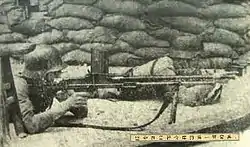
In the early morning of 29 October, residents of Shanghai found a 4-metre-wide (13 ft) flag of the Republic of China flying atop Sihang warehouse. Yang Huimin had only brought the flag, and the defenders did not have a flag pole in the warehouse. Therefore, the flag was hoisted on a makeshift pole made of two bamboo culms tied together. Only a small group of soldiers attended the flag-raising ceremony.[21]
The crowd gathered across the river, reportedly thirty thousand strong,[31] was jubilant, shouting "Long live the Republic of China!" (Chinese: 中華民國萬歲!; pinyin: Zhōnghuá Mínguó wànsuì!), while the Japanese were furious and sent aircraft to attack the flag.[16] Because of heavy anti-aircraft fire and fear of hitting the foreign concessions, the planes soon left without destroying the flag. Meanwhile, two days of fighting had damaged or destroyed many field fortifications around the warehouse, and the warehouse itself was also damaged.
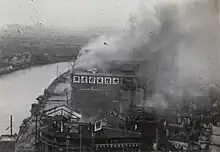
At noon the Japanese mounted the largest assault thus far. Hundreds of Japanese infantry attacked the warehouse from all directions with artillery fire and support from Type 94 Te-Ke tankettes.[32] Warned of the attack by spectators, Chinese soldiers resisted the assault from all three sides under intense artillery fire. The Japanese assault pushed the 3rd Company out of their defensive line at the base of the warehouse and forced them into the warehouse itself. The west side of the warehouse originally lacked windows, but the Japanese artillery attacks conveniently opened up firing holes for the defenders. Groups of Japanese soldiers tried to scale the warehouse's walls to the second floor with ladders, but Chinese defenders pushed them over and returned fire with rifles and machine guns.[33] Xie just happened to be at the window where one of the ladders appeared from. He grabbed the first Japanese soldier's rifle, choked him with the other hand, pushed him off, and finally shot another Japanese soldier on the ladder before pushing the ladder off.[27]
During the height of the battle, a group of Japanese soldiers attempted to plant explosives at the base of the West Wall to breach it. Upon noticing this, 21-year old Chinese private Chen Shusheng, strapped grenades to himself and jumped off the building into the group of Japanese soldiers, killing twenty Japanese soldiers in a suicide attack.[16][34][35][36] The fighting lasted until dark, with Japanese waves now frequently supported by armoured fighting vehicles and artillery fire against the fortified Chinese positions, but to no progress and with heavy casualties.[26]
Japanese troops attempted to flank the warehouse from the river, but were stopped by an makeshift boom fashioned out of Chinese junks at the Zhejiang Road Bridge. British troops in the Settlement refused to move the boom due to the violation of the British Settlement sector, and escorted the Japanese sailors back.[37]
Finally, after all else had failed, the Japanese used an excavator and tried to dig a tunnel towards the warehouse. in conjunction with tank assaults. During this day's battle, Chinese citizens across the river helped the soldiers by writing on large posters, warning of the Japanese army's movements.[16]
October 30 to November 1
The Japanese launched a new wave of attack at 7 a.m. on the 30th. There were fewer infantry assaults at the warehouse this time; the Japanese attack was mainly concentrated artillery fire. Because of the sturdy construction and the abundance of sandbags and materials with which to fortify and mend the warehouse, the defenders simply repaired the warehouse while the Japanese tried to destroy it. Artillery fire was so rapid, recalled Yang Ruifu, that there was approximately one shell every second.[16] When night approached, the Japanese deployed several floodlights to illuminate the warehouse for their artillery to strike at. The battle on the 30th lasted the whole day, with the defenders destroying and damaging several armoured cars.
The foreigners in the concessions in Shanghai did not want the site of combat to be so close to them. With that consideration in mind, and faced with pressure from the Japanese, they agreed to try to convince the Chinese to cease resisting. On the 29th the foreigners submitted a petition to the Nationalist Government to stop the fighting "for humanitarian concerns". To Chiang, the battle was already won as most of the Chinese forces in Shanghai had successfully been redeployed to defend more favourable positions, and the defense of the warehouse now had the attention of the western world, so he gave the go-ahead for the regiment to retreat on 31 October. A meeting was arranged with the British general Telfer-Smollett through the commandant of Shanghai Auxiliary Police (上海警備), Yang Hu (楊虎),[15] and it was decided the 524th would retreat to the foreign concessions and then rejoin the rest of the 88th Division, which had been fighting in west Shanghai. The Japanese commander Matsui Iwane also agreed and promised to let the defenders retreat, but later reneged on the deal. Xie, on the other hand, wanted to remain in the warehouse and fight to the last man. Zhang Boting finally convinced Xie to retreat.[15][38]
At midnight, 1 November, Xie led 376 men in small groups toward the British concession across New Lese Bridge. At least ten defenders had died during the battle, and another 27 were too heavily wounded to be moved. Consequently, these men agreed to stay behind to man the machine guns and cover the retreat of the remaining forces.[16] During the crossing, about between two and six soldiers were killed, and ten soldiers were wounded by Japanese machine gun and artillery fire.[39] By 2 a.m. the retreat was complete.
Japanese Account of Events
.jpg.webp)
The Imperial Japanese Navy did not regard the Defense of Sihang Warehouse as a battle, but rather as part of their advance on Chapei conducted from October 27 through October 31, 1937. As a result, Japanese military records on the event are not particularly detailed.
At 0505 hours on October 27, 1937, the Imperial Japanese Navy's Shanghai Special Naval Landing Force (Shanghai SNLF) ordered their forces to launch a general assault on Chapei. With few of Chiang's defenders left in the Chapei, the Shanghai SNLF moved through the district and captured former enemy strongholds with relative ease. By around 1800 hours Chapei had largely fallen to the Japanese, with the exception of the Four Banks' Joint Warehouse (Sihang Warehouse), where the Shanghai SNLF reported approximately 800 enemy troops to still be held up at.[8]
The Japanese initially advised the troops held up in Sihang Warehouse to surrender, but by the early hours of October 31 with their demands still unmet and signs of the defenders making an escape into the British defense sector of the International Settlement, the Japanese decided to attack the warehouse. On October 31 at 0115 hours the Imperial Japanese Navy confirmed sightings of Chinese troops evacuating into the International Settlement and began to bombard the warehouse with artillery fire from the Shanghai SNLF's 8th and 9th Companies thirty minutes later. At 0300 hours, troops from the Shanghai SNLF's 10th Battalion stormed the Sihang Warehouse and within ten minutes had completely cleaned the warehouse of enemy troops and occupied the building.[8][1][7]
After securing the warehouse, the Imperial Japanese Navy reported roughly 80 corpses of fallen Chinese troops and a number of weapons to be inside. The Imperial Japanese Navy's advance on Chapei from October 27 to 31 resulted in a total of 42 wounded, four of which were directly injured during the assault on Sihang Warehouse on October 31. Of the total wounded in the advance on Chapei, two would later succumb from their injuries, including Warrant Officer Tanaka—a platoon leader from the Shanghai SNLF 10th Battalion—who was shot while skirmishing around the warehouse on October 30 and later died on November 2, 1937.[7][8][9]
Aftermath
After the retreat the remaining soldiers set forth to regroup with the rest of the 88th Division. However, British troops seized all their weapons and placed the soldiers under arrest. The reason was that the Japanese threatened to invade the concessions if the soldiers were allowed to leave the area. They were herded into the Italian area of the concessions and fenced off.
The Chinese casualties from the battle were disputed; immediate newspapers and reporters claimed between 100 and 200 Chinese soldiers had been killed in the fighting.[40][41] Xie Jinyuan stated in an interview on November 2 that of the 410 defenders, 10 had been killed and 30 wounded,[42] but later revised this figure to 420 defenders present with 10 killed and 37 wounded.[43] The Imperial Japanese Navy reported finding around 80 dead Chinese soldiers in the warehouse.[7]
A 2022 strength data analysis found that since 377 defenders had retreated (along with the 10 wounded men evacuated earlier), and 420 defenders had been present, the Chinese "death toll was likely higher [than 10] though probably fewer than 50 men," with 33 men killed or missing from the battalion roster following the retreat.[44]
Immediately after the battle, Xie Jinyuan stated an excess of 100 Japanese troops had been killed by the defenders.[10] The Japanese casualties asserted by the Chinese would increase postwar, with Sun Yuanliang later estimating that "Enemy corpses in the vicinity of Sihang Warehouse totalled over two hundred approximately."[45] and Xie Jimin alleging "more than 200 enemy troops were killed and countless ones were wounded. Two enemy tanks were also destroyed and two more were damaged. The number of enemies was the sum of the daily counts obtained by observation posts."[29]
Formerly classified records from Imperial Japanese Navy reported a total of 42 wounded during the advance on Chapei from October 27 to 31. Within this figure, four of the wounded sustained their injuries during the final assault on Sihang Warehouse on October 31. Two of those wounded in the advance on Chapei later died of their injuries, including one officer shot outside of the warehouse on October 30 who eventually died on November 2, 1937. The use of tanks—let alone the loss of them—during the assault on the warehouse is absent from Japanese military records.[7][8][9] The lack of Japanese corpses left on the battlefield to support the purported Chinese claims has been attributed to dogs dragging away the fallen Japanese troops.[46]
Chiang Kai-shek promoted every defender by a rank and awarded Xie Jinyuan and Yang Ruifu the Order of Blue Sky and White Sun.[47][48]
After their incarceration, citizens of Shanghai would often visit the troops, giving them performances and entertainment. The officers opened classes for the soldiers, teaching foreign languages, mathematics, and even Christian theology. Chen Wangdao, the Chinese translator of the Communist Manifesto, also visited the camp from time to time. The soldiers spent their day doing military drills and kept their fighting spirit high. Their practice of singing the National Anthem of the Republic of China every day was continuously disrupted by the foreign authorities, until it was violently put down by White Russian mercenaries.
Faced with defeat in the Battle of Shanghai and the loss of a third of the National Revolutionary Army's best-trained troops, the failed but morale-boosting defense of Shanghai proved to the Chinese people and foreign powers alike that China was actively resisting the Japanese. The media capitalized on the defense of the warehouse and lauded the Eight Hundred Heroes, embellished from the original 414, as national heroes, and a patriotic song was also composed to encourage the people to resist Japanese aggression. However, the foreign aid that Chiang tried to canvass for did not arrive; none of the European powers delivered anything more than verbal condemnation of Japan. Only Germany and the Soviet Union provided substantial aid to China before the outbreak of war in Europe, and Germany withdrew its advisors in 1938 because of Japanese pressure.
Within the "Lost Battalion Barracks", the Heroes languished for more than three years. The Japanese had offered to free the soldiers, but only if they disarmed and left Shanghai as refugees. Xie did not agree to these terms, and after refusing numerous offers from Wang Jingwei's collaborationist government, Xie Jinyuan was assassinated on 24 April 1941 at 5 a.m. by Sergeant He Dingcheng and three others of his own troops, who were bought over by Wang Jingwei's government. He died at 6 a.m. More than 100,000 people turned up for his funeral, and he was posthumously made a brigadier general of the National Revolutionary Army.
After the Pearl Harbor attack, Japanese forces occupied the foreign concessions and captured the soldiers. They were shipped off to Hangzhou and Xiaolingwei to do hard labour. Part of the group sent to Xiaolingwei escaped, and some rejoined the Chinese forces to continue fighting the Japanese in a guerilla campaign with the New 4th Army.[49] Thirty-six officers and soldiers were sent to Papua New Guinea to do hard labour, and in 1945 when the war went against Japan, they overpowered their captors and took them prisoner instead.
When the Chinese Civil War broke out, most of the battalion returned to civilian occupations while some choose to fight for either the nationalists or the communists. As the tide of the battle turns against the Nationalists, many officers and some former soldiers, including Girl Guide Yang Huimin, retreated to Taiwan with the Kuomintang government. Soldiers that remained in mainland China are lauded as heroes of anti-imperialism, where they are allowed to keep their nationalist memorabilia such as their medals and uniforms, and also offered a pension and housing from the newly formed People's Republic of China. However, many of the soldiers chose to destroy their memorabilia and hid their history during the Cultural Revolution due to persecution from the Red Guards.[49]
Legacy
Due to a large discrepancy between Japanese combat reports and testimonies of Chinese troops and journalists present during the defense, many of the details have been called into question. Both the Chinese and Japanese have alleged claims which contradict with each other, particularly in regards to losses. Cao Juren, a prominent Chinese war correspondent attached to the Chinese 88th Division during the Defense of Sihang Warehouse, would state postwar "the news in the papers at the time, including my reports, were all bravado and exaggerations, and did not reflect the real situation."[50]
Xie Jinyuan's body was interred in a small garden along Singapore Road (now Yao Road) where his bunk used to be. In 1947 the Shanghai city government renamed Jiaoyuan Park (where the soldiers lived) as Jinyuan Park, and renamed an elementary school in the vicinity 12th District Jinyuan National Elementary School. The road to the west of the warehouse was renamed Jinyuan Road.
On 16 April 1983, Xie's grave was moved to the Wanguo Public Mausoleum (万国公墓), among other Chinese patriots buried there. In the same year, the barracks area was rebuilt and named Jinyuan Alley. In March 1986 the city council of Xie's hometown, Jiaoling, Guangdong, set up a monument in his honour, and his alma mater Jiankeng Elementary School was renamed Jinyuan Elementary School.
The renovated Sihang Warehouse (including an additional level and a new wing) is still standing, and part of it is now a repository of documents, photos and journals from the Battle of Shanghai. Most of the warehouse is still what it was meant to be—a furniture warehouse—and there is even a bowling alley on the third floor.
In 2005, to celebrate the 60th anniversary of the Chinese victory in the Second Sino-Japanese War, as well as the Allied victory in World War II, China Telecom released a set of themed telephone cards. One card featured Sihang Warehouse and Xie Jinyuan.
The story of the Eight Hundred Heroes has been made into the movies 800 Heroes (1938), Eight Hundred Heroes (1977), and The Eight Hundred (2020).
Gallery
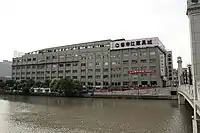 Sihang Warehouse from the other side of the Suzhou River. October 2006
Sihang Warehouse from the other side of the Suzhou River. October 2006 The entrance. October 2007
The entrance. October 2007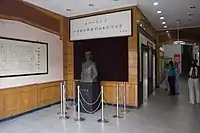 A bust of Army Lieutenant Colonel Xie Jinyuan inside the entrance. October 2007
A bust of Army Lieutenant Colonel Xie Jinyuan inside the entrance. October 2007
References
- "陸戦隊の部". Japan Center for Asian Historical Records. Retrieved 28 July 2023.
- Harmsen, Peter (2015). Shanghai 1937: Stalingrad on the Yangtze. Casemate. p. 173. ISBN 978-1-612-00167-8.
- "陸戦隊の部". C14120644700. Retrieved 24 March 2023.
- "主要作戦研究 陸1 上海確保戦(陸戦隊の部) 自8月13日至8月22日". Japan Center for Asian Historical Records. Retrieved 24 March 2023.
- Zhu, Xie (2010). My Father General Xie Jinyuan: Blood Fight of Eight Hundred Soldiers. United Press. p. 138. ISBN 978-7-512-60052-2.
- Robinson, Stephen (2022). Eight Hundred Heroes: China's lost battalion and the fall of Shanghai. Exisle Publishing. p. 117. ISBN 978-1-922539-20-5.
- "支那事変概報第39号 10月1日~支那事変概報第69号 10月31日(5)". Japan Center for Asian Historical Records. Retrieved 2 August 2023.
- "11.閘北進撃戦(10月27日)". Japan Center for Asian Historical Records. Retrieved 24 March 2023.
- 支那事変尽忠録 第三卷. 海軍省教育局. pp. 231–234. Retrieved 24 March 2023.
- "Standing firm in isolation and hardship for four days, the 800 heroes followed orders and made their retreat (CN:堅守孤壘苦鬥四日八百壮士遵命撤退)". Zhongyang Ribao. November 1, 1937. Retrieved 23 August 2023.
- Yuanliang, Sun (2002). "A Moment In A Billion Years". 8/13 Battle of Songhu (in Chinese). Shanghai Chinese Academy of Social Sciences. pp. 8–9.
- Robinson, Stephen (2022). Eight Hundred Heroes: China's lost battalion and the fall of Shanghai. Exisle Publishing. p. 117.
- Mulready-Stone, Kristin (2014). "Mobilizing Shanghai Youth" (1st ed.). Routledge. p. 127. ISBN 978-1138779853.
- Li, Junshan. "Defense of Shanghai and Nanjing". Taipei: Mai Tian Publishing, 1997, p. 124.
- Zhang, Boting. "Recollections of the 8/13 Battle of Shanghai". Zhuan Ji Wen Xue. Taipei: Academia Sinica, 1965, vol. 41.
- Yang, Ruifu. "The Lost Battalion's Four-day Struggle". 8/13 Battle of Songhu. Shanghai: Chinese Academy of Social Sciences, 2002, pp. 158–159.
- Sun, Yuanliang. "Xie Jinyuan and the Eight Hundred Heroes". 8/13 Battle of Songhu. Shanghai: Chinese Academy of Social Sciences, 2002. p. 115
- "支那事変概報第39号 10月1日~支那事変概報第69号 10月31日(4)". Japan Center for Asian Historical Records. Retrieved 4 August 2023.
- "第8編 緒戦期に於ける中・南支作戦/第2章 8月18日より8月下旬に至る上海作戦/第1節 上海陸上戦闘を中心とする作戦". Japan Center for Asian Historical Records. Retrieved 11 April 2023.
- Koizumi, Masayoshi (2009). Aru Kaigun Chusa Ikka no Kakei Bo. Kojinsha. pp. 192, 196. ISBN 9784769826019.
- Yang, Huimin. "Autobiography". 8/13 Battle of Songhu. Shanghai: Chinese Academy of Social Sciences, 2002. p.. 118
- Yang, Ruifu. Account of the Lone Unit's Four days of Battle (in Chinese). p. 121.
- Robinson, Stephen (2022). Eight Hundred Heroes: China's lost battalion and the fall of Shanghai. Australia: Exisle Publishing. p. 117. ISBN 978-1-922539-20-5.
- Lai. Shanghai and Nanjing 1937. p. 21.
- Yang, Ruifu. Account of the Lone Unit's Four Days of Battle. p. 122.
- Harmsen, Peter (2013). Shanghai 1937 (1st ed.). Stanford University Press. pp. 1907/6628.
- Shangguan, Baicheng. "Diaries of the Eight Hundred Heroes and Xie Jinyuan". 1977
- Robinson, Stephen (2022). 800 Hundred Heroes. Chatswood, Australia: Exisle Publishing. p. 274. ISBN 978-1-922539-20-5.
- Zhu, Xie (2010). My Father, General Xie Jinyuan. United press. p. 138. ISBN 978-7512600522.
- Xie, Jimin. "A Few Explanations Regarding Xie Jinyuan and the Eight Hundred Heroes". Shi Lin Xie Ying (Shanghai Historical Archive vol.88) Shanghai: Shanghai Committee of Chinese Political Consultative Conference, 1998. pp. 210–211
- "Our Determined Lone Army Makes Final Stand". Lihpao Daily 29 October 1937
- Niderost. Chinese Alamo.
- Niderost, Eric (2007). "Chinese Alamo: Last Stand at Sihang Warehouse". Warfare History Network. Retrieved June 18, 2023.
- Kubacki. . On The Precipice of Change. p. 54.
- Yang, Yi (19 August 2015). "Ba Bai Zhuang Shi" (in Chinese). Baike. Beijing Daily. Retrieved 15 September 2020.
- "Lest we forget the sacrifice of battle heroes". shanghai.gov.cn. Shanghai Municipal People's Government. 2 September 2020. Retrieved 15 September 2020.
- Japan's War in China. p. 92.
- Sun, Yuanliang. "A Moment In A Billion Years". 8/13 Battle of Songhu. Shanghai: Chinese Academy of Social Sciences, 2002. p. 120
- Su, Hua. "We Are Praying For You". Lihpao Daily, 2 November 1937
- ""Lost Battalion" Saved in Shanghai: Will be Interned". The New York Times. 1937.
- Lehrbas, Lloyd (1937). "Runs Gauntlet of Jap Gunfire".
- ""Lost Battalion" Men Promoted". 1937.
- Xie, Zhu (2010). My Father General Xie Jinyuan:Blood Fight of Eight Hundred Soldiers. United Press. p. 138. ISBN 978-7512600522.
- Robinson, Stephen (2022). Eight Hundred Heroes: China's Lost Battalion and the Fall of Shanghai. Australia: Exisle Publishing. p. 117. ISBN 978-1922539205.
- Yuanliang, Sun (2002). A Moment in a Billion Years: 8/13 Battle of Songhu. Shanghai: Chinese Academy of Social Sciences. pp. 8–9.
- Robinson, Stephen (2022). Eight Hundred Heroes: China's lost battalion and the fall of Shanghai. Australia: Exisle Publishing. p. 134. ISBN 978-1-922539-20-5.
- "Japanese Mop Up in Chapei." 1937.
- "Lone Battalion" Remembered.
- "Interview with the Last soldier of Sihang". Phoenix TV https://www.youtube.com/watch?v=sBlWF_mgacE , Retrieved 16 February 2023
- Cao, Juren (1983). Wanli Xingji (Chinese: 万里行记). Fujian People's Publishing House. p. 83.
External links
- Ba Bai Zhuang Shi at IMDb
- Brigitte Lin page on 1976 movie
- Chinese Movie Database page on the 1938 movie
- Chinese-American leaders petition the mayor of Shanghai for the preservation of Sihang Warehouse (in Chinese)
- Old survivors visit graves of old comrades-in-arms (in Chinese)
- Structural Analysis of Sihang Warehouse (Abstract) (in Chinese)
